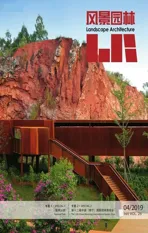成都“熊猫之都”总体规划
2019-12-03Sasaki事务所
Sasaki事务所
国宝大熊猫作为中国特有的生态保护和文化符号,是国际交流的友好使者,是仅栖息于中国西南的珍稀濒危野生动物。熊猫是世界各地动物园的镇园之宝,当今世界上仅存大约1 800只野生大熊猫。而成都作为世界上离大熊猫核心栖息地最近的城市,可谓名副其实的“熊猫之乡”,同时也是迅速扩张的大型城市。城市发展与生态保护往往相互冲突,但本项目通过规划69km2的3个熊猫片区,建构可持续发展框架来协调成都的城市化进程和大熊猫保护工作,带领成都打造永续的“熊猫之都”。
Sasaki为“成都大熊猫之都”定制的总体规划体现了近年中国为保护大熊猫及其栖息地不断加强沟通、合作与创新策略的意愿。大熊猫是同一区域内众多濒危野生动物不可或缺的伞护种,因此这个方案将有益更多物种的保护工作。项目通过一系列可持续性框架加强栖息地的保护,同时扩大国际研究协作和生态教育,最终努力让大熊猫能够在野外自由茁壮繁衍。
未来“熊猫之都”预计每年接待逾2 000万名访客,超过当今迪士尼乐园的庞大游客量。成都必须在平衡合理有序的城市发展的同时,确保对熊猫栖息地保护的重大任务。
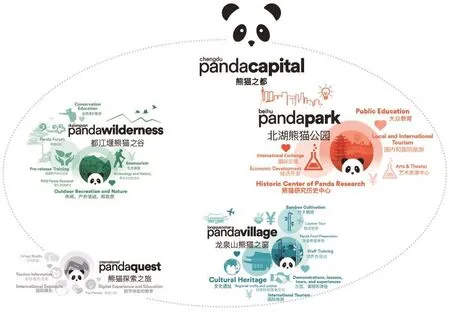
1 大熊猫之都Panda Capital
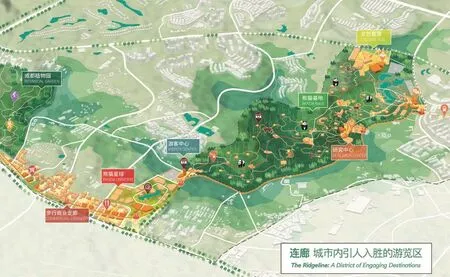
2 北湖熊猫公园游览总图Beihu Panda Park Tourist Map
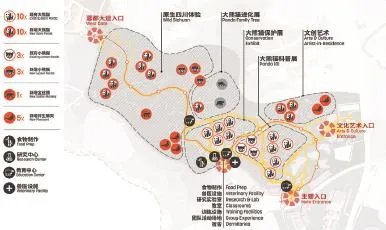
3 大熊猫基地动物场馆Panda Base Animal Facilities
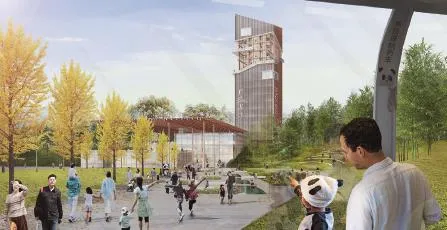
4 规划新增西入口效果图Proposed West Entrance
大熊猫保护区依据不同功能以及访客体验设立3个定位独特的熊猫体验片区。第一片区—北湖熊猫公园,依托于既有的大熊猫基地,Sasaki将此区升级为城市研究及教育中心,为访客提供沉浸式的自然体验。作为市区内重要的游览目的地,熊猫公园毗邻市中心,并拥有便捷可达的轨道和公共交通系统。每年将有千万名访客来到这里近距离了解和观赏大熊猫及其伴生物种,学习它们的栖息地及繁育保护工作。
第二片区——都江堰大熊猫谷,位于青藏高原和青城山山麓处,是距离成都市中心相对最远的片区。它既是通往大熊猫国家公园的门户,也是一座集研究、教育和体验一体的科研基地。研究人员将在这里为人工繁育的大熊猫幼崽进行野化培训,最终实现放归野外。
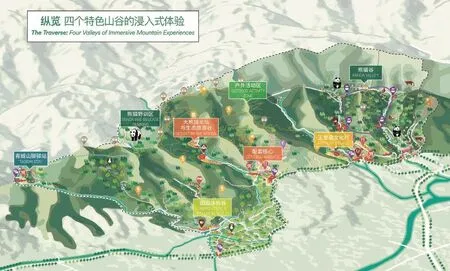
5 都江堰大熊猫谷游览图Dujiangyan Panda Wilderness Tourist Map
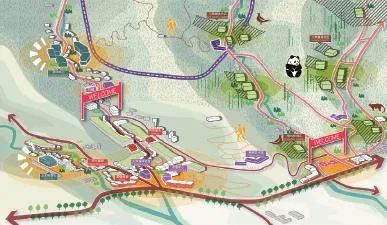
6 大熊猫谷山麓入口Wilderness Foothill Gateway
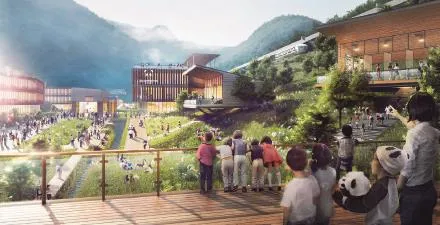
7 大熊猫科教中心效果图Panda Valley Research Center
第三片区——龙泉山熊猫之窗,位于天府空港新城和龙泉山城市森林公园交界处的特殊位置,是进入成都和了解大熊猫生态的第一站,也是体验天府文化,本地历史、美食,区域生态的门户。
要说全球最受欢迎的动物,大熊猫的地位大概无可超越。这种人见人爱的濒危物种,对成都来说尤其特别。Sasaki与当地市政府合作积极筹划城市发展策略,同时确保对大熊猫原生栖息地的保护不被忽略。目前Sasaki正筹备熊猫之都下一阶段的深化工作,为早日实现城市与自然和谐共生的可持续愿景而努力。
项目位置:中国成都
业主:成都天府绿道建设投资有限公司
现状:2018年10月设计完成
规模:69km2
设计范围:总体规划、景观及城市设计
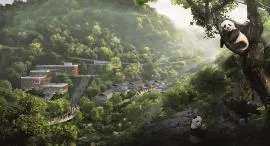
8 山顶熊猫野训图效果图Uphill Panda Pre-release Training Area

9 金丝猴体验区效果图Snub-nosed-monkey Exhibit
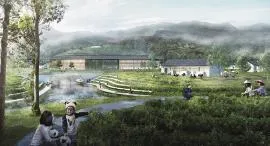
10 田园体验谷效果图Wellness Village and Farm
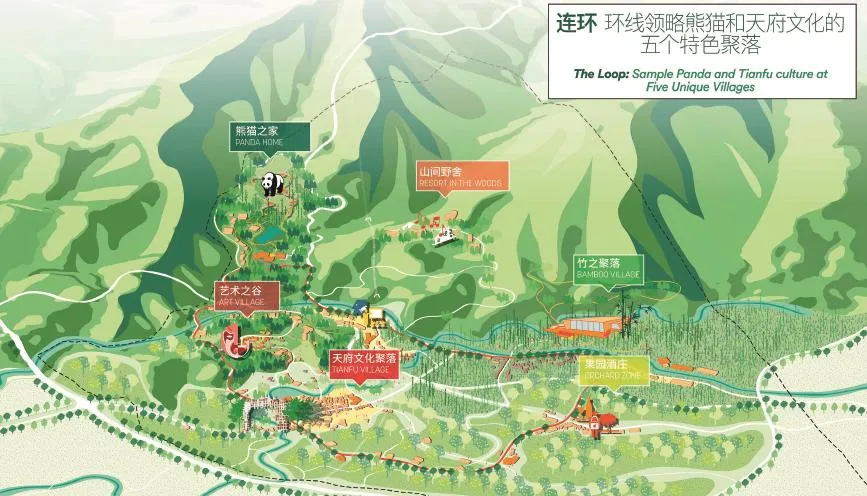
11 龙泉山熊猫之窗游览总图Longquanshan Panda Village Tourist Map
The giant panda is an icon of Chinese culture and a symbol for wildlife preservation efforts around the world. With only about 1,800 left in the wild, it is one of the most vulnerable species on Earth. Although a staple at many zoos around the world, giant pandas are native to only one region in western China near Chengdu, which is also one of the fastest growing cities in the world.Although urbanization and conservation are often in conflict with each other, the Chengdu Panda Reserve provides a framework for the protection of the giant panda and its native habitat, and strategies which will lead Chengdu into a more resilient future. The master plan for the Chengdu Panda Reserve represents the launch of China’s increasing communication, collaboration, and awareness of its pioneering strategies to protect the species and its native habitat. Conservation efforts have multiple benefits, as pandas serve as an‘umbrella species’ for other wildlife which indirectly benefit from the protection of their shared habitat.Sasaki’s plan for the reserve provides a framework for the protection of the species through a robust expansion plan focused on conservation, education,and research—with the ultimate objective of improving their ability to thrive in the wild.With over 20 million people expected to visit the Chengdu Panda Reserve each year—a figure that surpasses current annual visitors to Disneyland—the city has a tremendous responsibility to advance its development in a manner that is mindful of protecting the panda’s habitat.
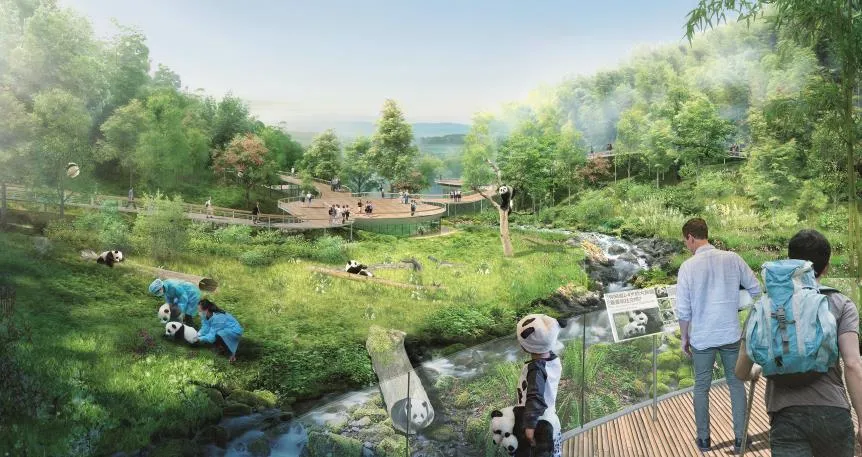
12 幼年熊猫展示及科研人员培训区Juvenile Panda and Staff Training Area

13 龙泉山熊猫之窗艺术村效果图Longquanshan Art Village
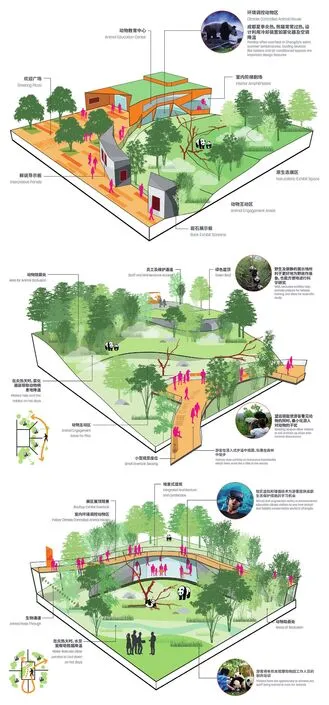
14 展区类型:浸入式体验Exhibit Typology: Intergrated Experiences
The three disparate sites which comprise the Chengdu Panda Reserve are organized by their primary functions, as well as the amount of human interaction and disturbance. The first site, Beihu Panda Park, builds upon the existing “Panda Base”visitor experience by providing an urban education center to accommodate those seeking a more immersive experience. This urban destination, close to downtown and linked to the city by public transit,introduces the panda to the millions of people who come to Chengdu each year to experience them up close. Here, visitors can learn about the daily lives of pandas and their companion species, their shared habitat, and get a glimpse into ongoing research and other efforts to protect them.
The second and most remote of the three sites that comprise the Chengdu Panda Reserve is the Dujiangyan Panda Wilderness. Primarily focusing on research, including breeding techniques and assimilation into the wild, this more isolated area of the reserve is located at foothills of the Tibetan plateau. As one of the gateways into the Giant Panda National Park,researchers here focus on pre-release training to acclimate juvenile pandas born in captivity prior to final release into the wild. The third site, Longquanshan Panda Village, is located near Chengdu’s new airport and provides an abbreviated glimpse into conservation efforts and highlights Chengdu’s distinctive culture.This gateway into the city will provide an educational overview of the region’s history, food, and wildlife,including the prized native panda.
It is difficult to name an animal more beloved than the giant panda. The near-universal adoration of this endangered species was never far from mind as Sasaki collaborated with city leaders to thoughtfully grow the city while building a resilient future for the species. Throughout 2019, Sasaki is continuing design work with the Reserve to prepare for its implementation in the near future.
Project location:Chengdu, China
Client name:Chengdu Tianfu Greenway Construction Investment Co., Ltd.
Completion date:Conceptual Master Plan completed in October 2018
Size:69 km2(approximately 27 square miles)
Services:Planning, Urban Design, Landscape Architecture,and Ecology
